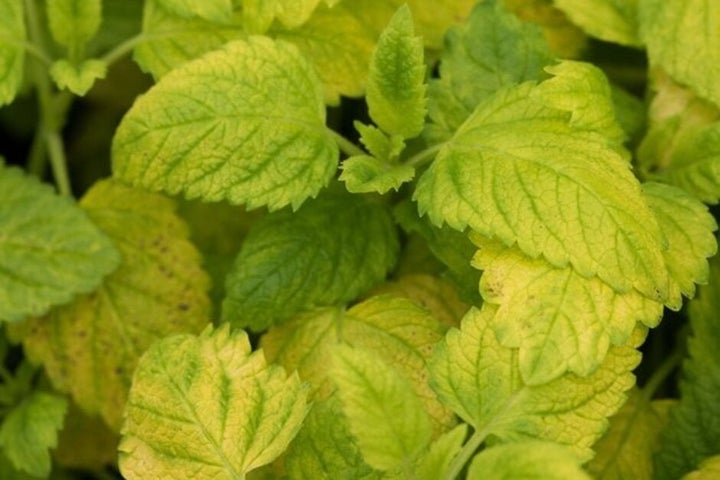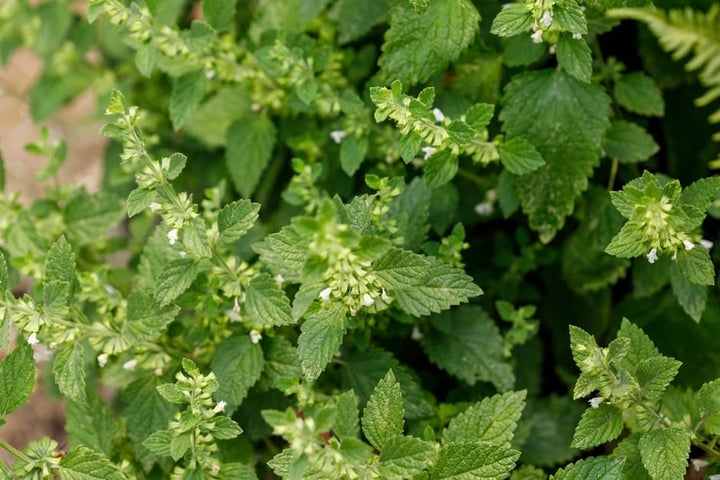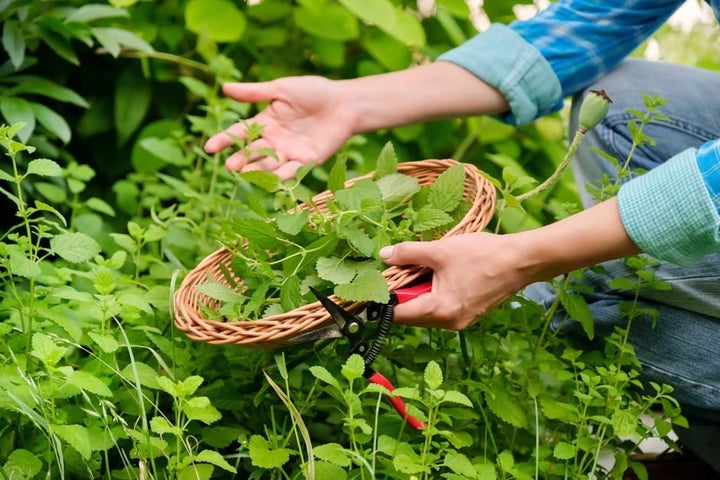Getting Started

Lemon balm (Melissa officinalis) is a vigorous herbaceous . It is fully hardy, easy to grow, happy in sun or partial shade and tolerates a range of soil types. Plants form a large leafy clump, with flower stems up to 90cm (3ft) tall. The leaves have a refreshing lemony fragrance and flavour. They can be harvested from spring into autumn, for use in salads, various cooked dishes and desserts, and to make a refreshing tea.
Lemon balm's white summer flowers are small but rich in nectar, so are a magnet for bees. In fact lemon balm’s botanical name, Melissa, derives from the Greek for honeybee.
Month by Month
Sow
Plant
Harvest
Choosing What To Grow

Lemon balm is one of the easiest and hardiest lemon-scented herbs to grow in the UK. There are several varieties too, such as yellow-leaved ‘All Gold’, ‘Aurea’ and lime-scented ‘Lime Balm’. The yellow-leaved forms make a vibrant splash of colour and are best grown in light shade.
Before sowing or planting lemon balm, just bear in mind that it’s a vigorous plant with a tendency to spread, and can take time to remove completely if you no longer want it. Grow lemon balm in a container if you don't want it to spread. Lemon balm also self-seeds unless you remove the faded flower stems promptly. If named varieties self-seed, the resulting plants may not have the same characteristics as the parent plant.
A wide range of herbs, including lemon balm, are grown in all the RHS gardens, so do visit them for inspiration and growing tips.
What and where to buy
The standard type of lemon balm, Melissa officinalis, is widely available from most gardening retailers, either as seeds or as small plants. To track down specific varieties, try specialist herb nurseries or larger plant suppliers – some varieties are only available as plants, not seeds.
Before you buy, it’s worth asking your gardening friends if they already have lemon balm. If so, it’s very easy to divide to make new ones. See Propagating below.
Recommended Varieties

Lemon balm
Melissa officinalis – the standard type. Vigorous, with a strong lemon flavour.

'All Gold'
Golden-yellow leaves with a strong lemon fragrance and flavour. Grow in light shade.
Sowing
Lemon balm is easy to grow from seed in spring, either indoors or direct outside, in the ground or in a pot. Only sow a few seeds, as one or two plants is probably enough for most uses. Once established, lemon balm usually self-seeds freely, so you’ll probably find plenty of popping up around your garden in future years.
Sowing indoors
Sow seeds indoors in spring, in a small pot or modular tray filled with moist peat-free . Cover with only a very thin layer of fine . Place in a or cover with a clear plastic bag and place in a warm, bright spot. As soon as appear, which can take up to three weeks, remove the cover. Keep them in a warm, bright spot and aim to keep the compost slightly moist.
Sowing outdoors
Sow lemon balm seeds outdoors from late spring to early summer. Choose a sunny or lightly shaded spot. Before sowing, weed the ground thoroughly then fork it over to break up any hard lumps. Remove any stones and rake to a fine texture. Alternatively, if you’re practising no-dig, the surface with a layer of well-rotted, fine organic matter and sow directly into the mulch. If sowing into containers, use a good quality peat-free, loam-based . Sow thinly and only lightly cover the seeds with soil or compost, as some light aids .
Planting

Newly bought lemon balm plants can be planted outside at any time of year, although spring is an ideal time. Young plants raised from seed can be planted outdoors from late spring onwards. Harden off indoor-raised plants to slowly acclimatise them to outdoor conditions. Choose a planting location in sun or partial shade. Lemon balm tolerates most soil types, but avoid sites. Lemon balm can also be planted in large pots at least 25cm (10in) wide and deep, filled with peat-free . This is a good option if you want to curtail its tendency to spread.
Plant Care
Lemon balm needs little maintenance apart from cutting back after flowering, especially if you don’t want it to self-seed, and dividing every few years so clumps don’t get too large and unruly. Plants in containers will need watering to keep the evenly moist, but in the ground shouldn't need watering.
Cutting back
Lemon balm can look rather straggly after flowering and the leaves might start to look a bit tatty. To encourage a fresh flush of tasty new leaves, cut the whole plant down to just above the base. Do this straight after flowering, before seeds form, if you don’t want more plants popping up in your garden.
As lemon balm is a herbaceous , it naturally dies down over winter, so cut back the faded stems by early spring, before new growth appears.
Propagating

It’s very easy to make new lemon balm plants by lifting a clump and dividing it into several smaller plants in spring or autumn. This should be done every few years, as lemon balm tends to form a large clump if left unmanaged. Dividing will provide you with new plants to grow elsewhere in your garden or share with friends. This is also the easiest way to propagate lemon balm varieties, which often don’t come true from seed.
You can also take from lemon balm, this is best done from mid-spring to early summer. Stems also root readily in a jar of water and can then be potted up.
Lemon balm also self-seeds readily unless cut back after flowering, so you’ll find new plants naturally appearing around your garden.
Harvesting

Pick lemon balm leaves whenever needed through spring and summer. Select the youngest leaves and use as fresh as possible, when full of flavour. Add to both savoury and sweet dishes, including salads, chicken and fish, fruit salads and other desserts. You can also infuse them to make fresh lemon balm tea, which is said to aid relaxation and digestion.
Lemon balm naturally dies back in autumn once temperatures drop, but harvesting can resume in spring when new growth appears.You can dry the leaves to make tea over winter, although the flavour is much milder than with fresh leaves.
Problem Solving
Lemon balm is generally robust, healthy and easy to grow, with few problems. In fact, it can be a little too vigorous, often forming a large clump in just a few years. It will also self-seed readily if you leave the spent flowers to produce seeds.
Although fully hardy, lemon balm will suffer in cold, soggy conditions over winter, which can cause the roots to rot, so make sure the soil or doesn’t get . Plants in containers are best moved into a sheltered spot over winter, out of excessive rain. Lemon balm leaves may sometimes be affected by leafhoppers and – cutting back affected stems will stimulate new, fresh shoots. See Common problems below for more information.
Common Problems

Powdery mildews
Powdery mildews are a group of related fungi which attack a wide range of plants, causing a white, dusty coating on leaves, stems and flowers.

Sage and Ligurian leafhoppers
Sage and Ligurian leafhoppers can cause a coarse pale mottling on sage, rosemary, lavender and related plants in the spring and summer.



